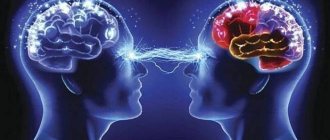- How NLP works
- What are beliefs
- How to change beliefs using NLP methods
- Types of beliefs in NLP
- Stages of setting adjustments
- An example of working with beliefs
People perceive reality through the prism of internal, subjective values. They are not always positive and useful for life. Changing beliefs with the help of NLP allows you to rebuild your belief system. As a result, the person will be able to be directed towards progressive and positive development.
What are beliefs
Beliefs are a stable system of views, ideas about the world, life, events, people around you, and yourself. These views and ideas are based on acquired knowledge, life experience, faith, attitudes towards something, desires and ideas.
Personal values are formed from beliefs, in close connection with them. Value is the importance, significance, usefulness and benefit of something for an individual.
The well-being of life largely depends on the system of subjective views and value guidelines. If they correspond to the value system of the society where the individual lives, it is much easier for him to achieve success, harmoniously integrate into the existing system, and take a well-deserved place in society. If beliefs contradict the value guidelines of society, the individual faces many difficulties and makes “mistakes” on his life path.
Beliefs are necessary for an adequate perception of reality. People cannot be critical of everything around them all the time. The experience and knowledge that they have already encountered become beliefs, so that when faced with this experience and knowledge the next time, a person does not build new ideas, but is based on an already existing system of ideas and views on the surrounding reality.
The main purpose of beliefs is that they allow you to save time and resources in a fast-paced life.
Beliefs have two main disadvantages:
- static;
- subjectivity.
Unlike thinking, which is capable of constant transformation, beliefs cannot be mobile. They are firmly fixed in the consciousness. Abandoning or rebuilding them is problematic and difficult.
Any belief is based on personal knowledge and experience, which often contradicts objective reality. Subjective ideas and values do not allow us to adequately perceive ongoing events and phenomena.
Beliefs both help and harm. It all depends on their content and correlation with the rules accepted in society.
The ability to work with a system of views and values, i.e. the ability to transform and modify them, allows you to adjust life in general.
"Categorization"
These beliefs describe what is what, what belongs to what category. That is, for which “things” which rules are fulfilled (or not fulfilled).
Actually, all statements like “I am a genius”, “she is beautiful”, “all cats are cute”, “I don’t like blondes”, “I like burritos” are beliefs about attitude to the category. That is, a person places himself in the “genius” category, “her” in the “beauty” category, and blondes in the “don’t like” category. As you can imagine, all identity beliefs are of this type: “I am a genius,” “he is an idiot,” “I am a motorcycle racer.”
— Petrov is a successful businessman. [“Petrov” is included in the category of “successful businessmen”]
— Mercedes produces good cars. [cars falling into the “good cars” category]
- I don't deserve happiness. [“I” do not fall into the “deserving of happiness” category]
— Health is important. ["Health" is included in the "important" category]
The full form for this type of belief must include a rationale for why “A is in category B”—usually a statement of satisfaction of the criterion: “Petrov is a successful businessman because he has a million-dollar net worth.”
Identity
The most important among this type of beliefs would be the identity beliefs : “I am a good swimmer.”
Please note that if a person has assigned himself to a category (identity), then formally all beliefs about this value must be fulfilled:
— I am a good swimmer because I trained a lot. [cause]
— I am a good swimmer, so I am invited to important competitions. [consequence]
— I am a good swimmer, because I can swim a hundred meters and not get out of breath. [criteria]
— I am a good swimmer, which means that I swim better than most other people. [definition] But in reality, things are often not quite like that - and this can be used to change or strengthen a belief.
How to change beliefs using NLP methods
Our beliefs form a large number of prohibitions/permissions in everyday life, setting tasks, and relationships with people. The established value system does not allow one to react flexibly to a changing world in order to solve pressing life problems.
NLP, focused on achieving goals and practical implementation of the skills of other people, allows you to effectively modify and correct the internal attitudes of the individual.
Changing beliefs using NLP allows you to achieve the following goals:
- Discover hidden personal talents.
- Achieve success in various fields of activity.
- Improve communication skills.
- Improve your professional, personal and creative life.
Types of beliefs in NLP
NLP practitioners distinguish 2 types of beliefs:
- deep;
- limited.
Deep attitudes are laid down in childhood, in the process of education. Beliefs, expressed in the form of all kinds of phobias, complexes, and fears, have a negative impact on life. Limiting beliefs are embedded in a person’s subconscious, he is not even aware of them. This system of views is expressed in the expressions: “I can’t”, “I don’t know how”, “I won’t learn”, “this is not my level”, “I’m not worthy”, etc.
A key model for changing beliefs using programming was developed by US psychologist Robert Dilts.
Stages of setting adjustments
Robert Dilts' model implies the following stages of changing an individual's value system:
- Collection of information. Accurate identification of all destructive beliefs and interfering values is carried out by analyzing a person’s life and conducting a survey using question phrases - “what’s bothering you?”, “what’s stopping you?”, “what upsets you most in life now?”
- Revealed beliefs are called into question. The experience experienced is wrong, and as a result, the conclusions drawn are also wrong. Question phrases are transformed into positive exclamatory statements - “I can do it!”, “Everything will be fine!” This is how a new belief system emerges.
- Testing new beliefs. The attitude and behavior of an individual in certain conditions is assessed.
NLP techniques for changing the value system:
- Copying. Transferring to oneself the necessary external and internal traits of a successful person. These include clothing, facial expressions, speech, movements, and attitude towards certain phenomena.
- Manipulation. Three “yes” technique.
- Relaxation and distraction.
Linguistic programming techniques
Based on the following strategy:
- identifying a limiting view;
- questioning it by demonstrating the possibility of transformation;
- establishing a new, more effective belief by adopting a new image.
The same strategy is used when influencing people to change beliefs. - replacing concepts with related ones
- language tricks.
These methods are widely used in advertising, propaganda, and popular culture.
For example, an advertising slogan consisting of a structure calling for the purchase of a product and promising a happy consequence of this is a typical case of using NLP. “Buy this, and all the girls will be crazy about you” - this phrase violates the logic, the cause-and-effect relationship is not determined by anything. But with repeated repetition, the image becomes fixed in the mind: “this product leads to attractiveness to the opposite sex.”
Such techniques give results, which is why advertising, without exception, is either built on them or partially uses them.
Reimprinting
The name of this technique comes from the word “imprint”, meaning “imprinting”, i.e. any experience or set of experiences as a result of which a person developed certain beliefs. Often imprint situations are dead ends and cause a person to feel meaningless, hopeless, hopeless, etc. The point of imprinting is to find the resources necessary to change ingrained beliefs and update established behavioral patterns.
The use of the reimprinting technique is based, first of all, on identifying the symptoms of the imprint, which involves focusing on the very first appearance of any experiences associated with it and the beliefs that have arisen. After this, you need to mentally transport yourself to the moment that preceded the emergence of the imprint, return to the present state and look at the imprint from the position that preceded it.
The next stage is the search for positive intentions or secondary benefits that are hidden behind the established reactions and symptoms of the imprint and some other equally important components that require more detailed and scrupulous study.
The features of reimprinting and the procedure for its implementation can be found here.
12
Walt Disney's Creative Strategy
This technique is based on the many years of experience of the American animator and film director Walt Disney in the fields of business and creativity. The essence of his strategy is the ability to approach any issue from three different positions: a dreamer, a realist and a critic. This approach itself was called “imagining” by the author. Each of the three components makes its contribution to the search for an effective solution to any issue.
The main function of the dreamer manifests itself at the initial stage, when new goals and ideas are just being formed, and is focused on the future. The dreamer must help the person see how all the components of his plan fit together. The function of a realist is expressed in the search for tools suitable for the implementation of the intended plan, so that an abstract idea can take shape into something concrete. A realist helps a person move from thought process to action.
A critic, in turn, is needed to evaluate the emerging idea or planned plan to achieve a goal from a critical perspective. The critic is called upon to help a person find weak points in his plan, to try to identify potential problems or points that might have been missed. The critic also draws a person’s attention to such things as the environmental friendliness of the plan, its realism, secondary benefits, etc.
Approaching any task using Walt Disney's creative strategy greatly increases a person's effectiveness and personal productivity. You can learn more about this strategy here.
5
Wrong term
In the Russian-language literature on NLP, with the light hand of the first translators, the term “beliefs” appeared. Moreover, they denoted a certain system of views or a single idea without even thinking particularly about the use of this term. They say, “conviction”, and that’s it. Do we understand the term correctly, and therefore translate the original English term correctly? The purpose of this article is to answer these questions.
Is it worth mentioning once again how important it is for any practitioner of neurolinguistic programming to choose words?
Why NLP Doesn't Really Work
Scientific criticism
Some psychotherapists use NLP to treat fears, phobias, anxiety, low self-esteem, stress, post-traumatic syndrome, alcohol and drug addiction, and other psychological problems. The results of this therapy are ambiguous Neuro‑Linguistic Programming Therapy. Psychology Today. . NLP is not a strictly scientific technique Kandola A. What is NLP and what is it used for? Medical News Today, such as cognitive-behavioral therapy, and there are practically no experiments confirming that it works Neuro-Linguistic Programming Therapy. Psychology Today.
In 2012, British psychiatrists published the results of a study on the effectiveness of NLP practices. They were generally positive, but experts came to the conclusion Neurolinguistic programming: a systematic review of the effects on health outcomes. British Journal of General Practice, that the effects of neurolinguistic programming on psychological health are not well understood.
Slightly more optimistic results for NLP supporters were obtained by Holander J., Malinowski O. The Effectiveness of NLP: Interrupted Time Series Analysis of Single Subject - Data for One Session of NLP Coaching. Journal of Experiential Psychotherapy Dutch psychologists in 2021. After a single session of neurolinguistic programming, 64% of patients with non-serious psychological disorders reported an improvement in their state of mind. 25 people took part in the experiment. However, scientists from the Netherlands recommended further study of NLP techniques.
Many more scientists criticize neurolinguistic programming. Back in 2004, George Mason University professor Daniel Druckman published a study commissioned by the US Army. In it he concluded Druckman D. Be All That You Can Be: Enhancing Human Performance. Journal of Applied Social Psychology that NLP techniques do not work.
In 2010, Polish psychologist and scientific book author Tomasz Witkowski selected Witkowski T. Thirty-Five Years of Research on Neuro-Linguistic Programming. NLP Research Data Base. State of the Art or Pseudoscientific Decoration? Polish Psychological Bulletin of 315 articles on neuro-linguistic programming 63 published in journals ranked by the International Scientific Indexing (ISI), and analyzed the findings from them. Only 18.2% of studies confirm the effectiveness of NLP. 27.3% published indeterminate results. The majority (54.5%) refute the concept.
In 2014, a study was published by the Canadian Agency for Medicines and Technologies in Health. They concluded Neuro-Linguistic Programming for the Treatment of Adults with Post-Traumatic Stress Disorder, General Anxiety Disorder, or Depression: A Review of Clinical Effectiveness and Guidelines. Canadian Agency for Drugs and Technologies in Health. Rapid Response Report. that NLP does not help in the treatment of post-traumatic, anxiety and stress disorders.
Skeptics point out Roderique-Davies G. Neuro-linguistic programming: Cargo cult psychology? Journal of Applied Research in Higher Education that NLP followers use outdated ideas about the structure of the brain, make factual errors, and use pseudoscientific terminology. For almost half a century of the existence of neurolinguistic programming, not a single serious study has appeared confirming its effectiveness. Kandola A. What is NLP and what is it used for? Medical News Today.
Maria Nikolaeva
Specialist in philosophy, author of books on sociology, oriental psychotechnics, teacher, translator, researcher.
The ineffectiveness of NLP is associated primarily with the primitivization of the human psyche, the reactions of which are being tried to be reduced to computer technology, that is, “programming.” But if any PC program, even the most complex, is calculated down to the slightest step, then a person’s free will allows him to make completely unpredictable moves.
Attempts to reduce human behavior to a biocomputer and undertake its reprogramming cannot succeed in the same way that no artificial intelligence in the foreseeable future will be able to replace a creative person. All such prospects remain only science fiction, but do not become science. This is exactly how the benefits of NLP should be understood - as an instructive utopia that only emphasizes the difference between reality as such.
NLP and sects
Anthropology and sociology classify NLP as a phenomenon of the New Age, or religions of the new century. Simply put, to sects. In particular, it is alleged that cult followers use NLP methods to convert people. Timothy Leary in his book “Technologies for Changing Consciousness in Destructive Cults” points out that cults use neurolinguistic reframing and hypnotic trance techniques to recruit new sect members.
In general, NLP is a product of its time. The comparison with the New Age is not accidental: neurolinguistic programming appeared in the same era as the religions of the new century. Researcher of sects and cults Joseph Hunt called Hunt JS Alternative Religions: A Sociological Introduction. Ashgate. 2003. NLP as an alternative to Scientology. The same Bandler, a character absolutely in the spirit of that era, was a drug addict and underwent Psychotherapist Not Guilty in Prostitute's Murder. Los Angeles Times suspect in murder case.
2a.Language and culture form a map commonly shared by many people.
Two important characteristics of maps should be noticed. A map is not the territory it represents, but, if correct, it has a similar structure to the territory, which accounts for its usefulness. Alfred Korzybski
There are two important characteristics of the cards to note. A map is not the territory it represents, but if the map is correct, it shares a common structure with the territory, and this makes it useful. Alfred Korzybski.
People who study or consider human thinking in the context of more than one person understand, of course, that the same idea can be viewed differently by two different people. But they also understand something else: if a certain community of people shares a language and culture, then they will also, to a certain extent, share the meanings of words, the representations that stand behind these words. Most completely, different people of the same culture will separate directly perceived objects (for example, a house in the sense of “building”, matches, an apple) and actions (for example, take, give), and it is much worse to separate, or even not separate at all, concepts and abstract operations (to go far, just ask a friend who is completely unfamiliar with NLP to describe “your own state in terms of repsystems, and add which ones: visual, auditory, kinesthetic and olfactory,” and then observe the misunderstanding).
Another thing is people who are superficially familiar with NLP and are completely unfamiliar with the works of A. Korzybsky. For them, don’t point out anything - the importance of linguistic accuracy of instructions, the fact that there is programming in NLP, so the steps of the techniques must be performed in the original order, and not swapped, and the fact that if this is not done, the technique will be performed incorrectly , - to any of these comments you can get a puzzling answer: “And this is my card. As you know, it’s not territory.”, and this would mean the usual “get away from me.”
I anticipate that if we take the definition of “faith” and “conviction” from the dictionary, many of those who misinterpret Korzybski will say: “but in my map it’s not like this, but this way.” You can explain to them at length that explanatory dictionaries are compiled for a dual purpose:
1. reveal (express explicitly) verbal representations implicitly shared by an entire linguistic culture (perform linguistic modeling); 2. teach people the meanings of these verbal representations (install linguistic models).
But the Polish author Andrzej Sapkowski wrote about this most expressively, ironizing at would-be writers who did not know the realities of the Middle Ages and therefore made funny mistakes in their fantasy novels:
The critic knows his stuff. Fantasy is not fantasy, he says, the laws oblige it. A two-handed sword is a two-handed sword, chain mail is chain mail, a crossbow is a crossbow, a horse is a horse, a catfish is a catfish, and soap is soap. And we must admit: in many cases the critic is absolutely right. If the fantasy author claims that: a) the barbican (a watchtower in front of the fortress wall (historical)) is a device for destroying fortress walls; b) guisarma is the barracks of the city guard; c) drawn crossbows are carried in packs; d) catfish have scales; e) soap lathers in sea water, then such an author violates the principles of terminology, logic, does not know what he is writing about - ergo: he is a club, and not a war club, but a simple stick.
Andrzej Sapkowski, “In the Cowpat Mountains”
In order not to think of anything ourselves (after all, most of the readers are probably not native speakers of English-speaking culture), not to violate the “principles of terminology and logic” and to clearly understand what is meant in English-language sources by the word belief, I suggest turning to the least biased and most reflective of the language map an entire culture to explanatory dictionaries.











